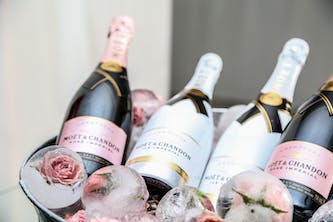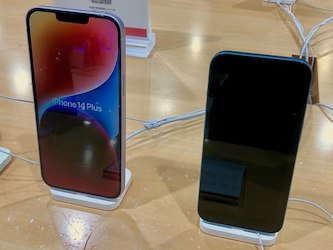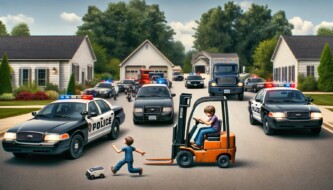Thieves in France successfully stole two truckloads of champagne, valued at €600,000, before being pursued by the police in a high-speed chase. The incident took place near Reims, which is located in the Champagne region. The stolen lorries were equipped with tracking devices, allowing the police to locate them and give chase on the A4 motorway between Reims and Paris. Although the champagne was eventually recovered, the thieves managed to escape. The lorries were stolen from a company based in Reims, and the stolen champagne consisted of bottles of Moët & Chandon, a renowned brand. Each load was valued at €300,000. The lorries were tracked near Pontault-Combault, about 20km from central Paris, and two police cars were involved in the chase. The thieves attempted to evade capture by swerving abruptly. One of the lorries was forced to slow down by the officers, and the driver jumped off and was picked up by a saloon car that was following the convoy. The car then sped away. The second lorry took the next exit and was later found without the driver. An investigation is currently underway. Fortunately, all the champagne bottles were retrieved intact, although they may have been slightly shaken during the chase.
Original news source: French police thwart €600,000 champagne heist (BBC)
Listen
Slow
Normal
Fast
Group or Classroom Activities
Warm-up Activities:
– News Reporter Role-play
Instructions: Students are divided into groups of three. One student acts as the thief, another as a police officer, and the third as a news reporter. The reporter interviews the police officer and the thief about the champagne heist and the high-speed chase. They should use information from the article and improvise additional details. After the role-play, discuss the different perspectives and language used.
– Article Timeline
Instructions: Provide the students with a list of the main events from the article (e.g., theft of champagne, police chase, recovery of goods). Individually or in pairs, students must arrange these events in chronological order as quickly as possible. This activity tests their comprehension and retention of the article’s content.
– Opinion Spectrum
Instructions: Present students with different statements regarding the champagne theft, such as “High-speed chases are too risky for recovering stolen goods” or “Luxury items like champagne are too heavily targeted by thieves.” Students position themselves along a line in the classroom according to how strongly they agree or disagree with each statement. They then discuss their opinions in small groups or with a partner.
– Vocabulary Pictionary
Instructions: Write down key vocabulary from the article (e.g., “champagne,” “lorries,” “tracking devices,” “high-speed chase,” “evade,” “saloon car,” “intact”). Students take turns drawing the words on the board without speaking or writing letters, while the rest of the class tries to guess the word. This helps reinforce new vocabulary in a fun and interactive way.
– Future Predictions
Instructions: Ask students to write a short paragraph predicting what will happen next in the story of the champagne heist. Will the thieves be caught? What will be the consequences for the champagne company? Encourage them to use future tenses and modals of speculation. After writing, students share their predictions and discuss which seem the most plausible.
Comprehension Questions:
1. What was the value of the champagne stolen in the incident near Reims, France?
2. Where is Reims located and why is it significant to the story?
3. How were the police able to locate and chase the stolen lorries?
4. What brand of champagne was stolen from the company based in Reims?
5. What was the value of each load of stolen champagne?
6. Where were the lorries tracked and how far is it from central Paris?
7. Describe the escape method used by the driver of one of the lorries.
8. What was the condition of the champagne bottles after they were recovered?
Go to answers ⇩
Listen and Fill in the Gaps:
Thieves in France successfully stole two (1)______ of champagne, valued at €600,000, before being pursued by the police in a high-speed chase. The incident took place near Reims, which is located in the (2)______ region. The stolen lorries were equipped with tracking (3)______, (4)______ the police to locate them and give chase on the A4 (5)______ between (6)______ and Paris. Although the champagne was eventually recovered, the (7)______ managed to escape. The lorries were stolen from a company based in Reims, and the stolen champagne (8)______ of bottles of Moët & Chandon, a renowned brand. Each load was valued at €300,000. The lorries were tracked near Pontault-Combault, about 20km from central (9)______, and two police cars were involved in the chase. The thieves (10)______ to (11)______ capture by swerving abruptly. One of the lorries was forced to slow down by the officers, and the driver jumped off and was (12)______ up by a (13)______ car that was following the convoy. The car then sped away. The second lorry took the next exit and was later found without the driver. An (14)______ is currently underway. Fortunately, all the champagne bottles were (15)______ intact, although they may have been slightly shaken during the (16)______.
Go to answers ⇩
Discussion Questions:
Students can ask a partner these questions, or discuss them as a group.
1. What is your opinion on the effectiveness of tracking devices in preventing theft?
2. How would you feel if a product from your region gained international fame like Champagne from Reims?
3. Do you think high-speed chases are an effective way to catch criminals? Why or why not?
4. Have you ever experienced a theft or been in a situation where something valuable was stolen? How did it impact you?
5. What do you think motivates people to commit crimes like the champagne theft?
6. Do you believe that the reputation of high-end brands like Moët & Chandon makes them a target for theft?
7. How do you think the company that owned the champagne feels about the incident?
8. Do you think that the media coverage of such thefts can influence future crimes?
9. What is your stance on the punishment for grand theft? Should it be more or less severe?
10. Have you ever visited a region known for a specific product, like the Champagne region in France? What was that like?
11. Do you like the idea of luxury items being equipped with security features, such as tracking devices?
12. How do you think the police could improve their strategies in catching thieves who are in the middle of committing a crime?
13. Do you think the thieves had inside information about the trucks, or was it a random act?
14. What measures do you think companies should take to protect their goods from theft?
15. Do you believe that recovered stolen goods should be sold at a discount or at full price? Why or why not?
Individual Activities
Vocabulary Meanings:
Match each word to its meaning.
Words:
1. Thieves
2. Champagne
3. Lorries
4. Police
5. Chase
6. Motorway
7. Capture
8. Investigation
Meanings:
(a) The act of pursuing someone or something
(b) A type of sparkling wine
(c) Law enforcement officers
(d) Large vehicles used for transporting goods
(e) People who steal things
(f) The process of examining or researching something
(g) A road designed for high-speed traffic
(h) The act of catching or apprehending someone
Go to answers ⇩
Multiple Choice Questions:
1. Where did the incident of the stolen champagne take place?
(a) Paris
(b) Pontault-Combault
(c) Champagne region
(d) Reims
2. How much was the stolen champagne valued at?
(a) €300,000
(b) €600,000
(c) €900,000
(d) €1,200,000
3. How were the stolen lorries tracked by the police?
(a) They were equipped with tracking devices
(b) They were followed by police helicopters
(c) They were spotted by a witness
(d) They were located using CCTV cameras
4. Where were the stolen lorries tracked near?
(a) Pontault-Combault
(b) Reims
(c) Paris
(d) Champagne region
5. How many police cars were involved in the chase?
(a) One
(b) Two
(c) Three
(d) Four
6. How did one of the lorries slow down during the chase?
(a) It ran out of fuel
(b) It crashed into a barrier
(c) The officers forced it to slow down
(d) It was blocked by traffic
7. What did the driver of the first lorry do during the chase?
(a) Surrendered to the police
(b) Continued driving until caught
(c) Abandoned the lorry and escaped on foot
(d) Jumped off and got into a saloon car
8. What happened to the second lorry during the chase?
(a) It crashed into another vehicle
(b) It was stopped by a roadblock
(c) It took the next exit and was later found without the driver
(d) It was intercepted by the police and the driver was arrested
Go to answers ⇩
True or False Questions:
1. All the champagne bottles were eventually recovered intact, although they may have been slightly shaken during the chase.
2. The stolen champagne consisted of bottles of Veuve Clicquot.
3. Each load of stolen champagne was valued at €300,000.
4. Thieves in France stole two truckloads of champagne valued at €600,000.
5. The thieves failed to escape despite the police chase.
6. The theft occurred in the Burgundy region near Reims.
7. The police were unable to locate the stolen lorries and pursue them on the A4 motorway.
8. The stolen lorries were equipped with tracking devices.
Go to answers ⇩
Write a Summary:
Write a summary of this news article in two sentences.
Check your writing now with the best free AI for English writing!
Writing Questions:
Answer the following questions. Write as much as you can for each answer.
Check your answers with our free English writing assistant!
1. How much was the total value of the champagne stolen in the incident near Reims, France?
2. What enabled the police to track and pursue the stolen lorries?
3. What specific brand of champagne was stolen from the company based in Reims?
4. Describe the method the thieves used to escape from the police after the high-speed chase.
5. What was the condition of the champagne bottles upon recovery, and what might be the impact of their condition?
Answers
Comprehension Question Answers:
1. What was the value of the champagne stolen in the incident near Reims, France?
The value of the champagne stolen was €600,000.
2. Where is Reims located and why is it significant to the story?
Reims is located in the Champagne region of France, which is significant because it is known for producing champagne, the very product that was stolen.
3. How were the police able to locate and chase the stolen lorries?
The police were able to locate and chase the stolen lorries because they were equipped with tracking devices.
4. What brand of champagne was stolen from the company based in Reims?
The stolen champagne was bottles of Moët & Chandon, a renowned brand.
5. What was the value of each load of stolen champagne?
Each load of stolen champagne was valued at €300,000.
6. Where were the lorries tracked and how far is it from central Paris?
The lorries were tracked near Pontault-Combault, about 20km from central Paris.
7. Describe the escape method used by the driver of one of the lorries.
The escape method used by the driver of one of the lorries involved slowing down the lorry and jumping off, after which the driver was picked up by a saloon car that was following the convoy and then sped away.
8. What was the condition of the champagne bottles after they were recovered?
The champagne bottles were retrieved intact, although they may have been slightly shaken during the chase.
Go back to questions ⇧
Listen and Fill in the Gaps Answers:
(1) truckloads
(2) Champagne
(3) devices
(4) allowing
(5) motorway
(6) Reims
(7) thieves
(8) consisted
(9) Paris
(10) attempted
(11) evade
(12) picked
(13) saloon
(14) investigation
(15) retrieved
(16) chase
Go back to questions ⇧
Vocabulary Meanings Answers:
1. Thieves
Answer: (e) People who steal things
2. Champagne
Answer: (b) A type of sparkling wine
3. Lorries
Answer: (d) Large vehicles used for transporting goods
4. Police
Answer: (c) Law enforcement officers
5. Chase
Answer: (a) The act of pursuing someone or something
6. Motorway
Answer: (g) A road designed for high-speed traffic
7. Capture
Answer: (h) The act of catching or apprehending someone
8. Investigation
Answer: (f) The process of examining or researching something
Go back to questions ⇧
Multiple Choice Answers:
1. Where did the incident of the stolen champagne take place?
Answer: (d) Reims
2. How much was the stolen champagne valued at?
Answer: (b) €600,000
3. How were the stolen lorries tracked by the police?
Answer: (a) They were equipped with tracking devices
4. Where were the stolen lorries tracked near?
Answer: (a) Pontault-Combault
5. How many police cars were involved in the chase?
Answer: (b) Two
6. How did one of the lorries slow down during the chase?
Answer: (c) The officers forced it to slow down
7. What did the driver of the first lorry do during the chase?
Answer: (d) Jumped off and got into a saloon car
8. What happened to the second lorry during the chase?
Answer: (c) It took the next exit and was later found without the driver
Go back to questions ⇧
True or False Answers:
1. All the champagne bottles were eventually recovered intact, although they may have been slightly shaken during the chase. (Answer: True)
2. The stolen champagne consisted of bottles of Veuve Clicquot. (Answer: False)
3. Each load of stolen champagne was valued at €300,000. (Answer: True)
4. Thieves in France stole two truckloads of champagne valued at €600,000. (Answer: True)
5. The thieves failed to escape despite the police chase. (Answer: False)
6. The theft occurred in the Burgundy region near Reims. (Answer: False)
7. The police were unable to locate the stolen lorries and pursue them on the A4 motorway. (Answer: False)
8. The stolen lorries were equipped with tracking devices. (Answer: True)
Go back to questions ⇧













